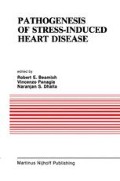Summary
Oxygen radical production by neutrophils stimulated the oxidation of adrenaline through the adrenochrome pathway. The two major catabolites on this pathway were adrenochrome and adrenolutin. A compound with the same retention time as adrenochrome on hplc was detected in a biological fluid rich in neutrophils. Oxidase activity was found in serum from patients following myocardial infarction which may be of importance in assessing the clinical and pathogenic significance of oxygen radicals in heart disease.
Access this chapter
Tax calculation will be finalised at checkout
Purchases are for personal use only
Preview
Unable to display preview. Download preview PDF.
Reference
Vulpian E.F.A., Note sur quelques reactions propres a la substance des capsules surrenales. C.R. Acad Sci (43), 663–665, 1856.
Bacq Z.M. The metabolism of adrenaline. Pharmacol. Rev. 1: 1–26. 1949.
Yates J.C, Beamish R.E., Dhalla N.S. Ventricular dysfunction and necrosis produced by adrenochrome metabolite of epinephrine; relation to pathogenesis of catecholamine cardiomyopathy. Am. Ht. J. 102; 210–221, 1981.
Beamish R.E., Dhillon K.S., Singal P.K., Dhalla N.S. Protective effect of sulphinpyrazone against catecholamine metabolite adreno-chrome induced arrhythmias. Am. Ht. J. 102; 149–152, 1981.
Kamazyn M., Beamish R.E., Fliegal L., Dhalla N.S. Adrenochrome induced coronary artery constriction in the rat heart. J. Pharm. Exp. Ther. 219; 225–230, 1981.
Misra H.P., Fridovich I. The role of superoxide anion in the autooxidation of epinephrine and a simple assay for superoxide dismutase. J. Biol. Chem. 247; 3170–3175, 1972.
Hallett M.B., Campbell A.K. Two distinct mechanisms for stimulation of oxygen radical production by polymorphonuclear leucocytes. Biochem. J. 216; 459–465. 1983.
Matthews S.B., Henderson A.H., Campbell A.K. The adrenochrome pathway; the major route for adrenaline catabolism by polymorphonuclear leucocytes. J. Mol. Cell. Cardiol, (in press) 1984.
Newby A.C. Role of adenosine deaminase ecto (5′-nucleotidase) and ecto (non specific phosphatase) in cyanide induced adenosine monophosphate catabolism in rat polymorphonuclear leucocytes. Biochem. J. 186; 907–918, 1980.
Hallett M.B., Luzio J.P., Campbell A.K. Stimulation of Ca++ dependent chemiluminescence in rat polymorphonuclear leucocytes by polystyrene beads and the non-lytic action of complement. Immunology 44; 569–576, 1981.
Green S., Mazur A., Shorr E. Mechanism of the catalytic oxidation of adrenaline by ferritin. J. Biol Chem. 220: 237–255, 1956.
Matthews S.B., Hallett M.B., Henderson A.H., Campbell A.K. The adrenochrome pathway: A potential catabolic route for adrenaline metabolism in inflammatory disease. Advances in Myocardiology 6, (in press) 1984.
Matthews S.B. The biological and clinical significance of adrenochrome. PhD thesis University of Wales, 1983.
Author information
Authors and Affiliations
Editor information
Editors and Affiliations
Rights and permissions
Copyright information
© 1985 Martinus Nijhoff Publishing, Boston
About this chapter
Cite this chapter
Matthews, S.B., Campbell, A.K. (1985). The Adrenochrome Pathway: Its Potential Significance in Stress Induced Heart Disease. In: Beamish, R.E., Panagia, V., Dhalla, N.S. (eds) Pathogenesis of Stress-Induced Heart Disease. Developments in Cardiovascular Medicine, vol 46. Springer, Boston, MA. https://doi.org/10.1007/978-1-4613-2589-5_24
Download citation
DOI: https://doi.org/10.1007/978-1-4613-2589-5_24
Publisher Name: Springer, Boston, MA
Print ISBN: 978-1-4612-9623-2
Online ISBN: 978-1-4613-2589-5
eBook Packages: Springer Book Archive

